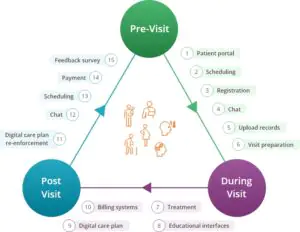
Recent advancements in healthcare technology have revolutionized the entire healthcare ecosystem. One of the important factors contributing to greater efficiency, better satisfaction, reduced costs, and enhanced health outcomes is Patient Engagement.
Patient engagement can be considered as a framework that encourages and allows patients to be part of their care journey on an ongoing basis. It ensures that the patients are well informed about all the possible treatments, recuperation, medication options at their disposal, and they participate in the decisions related to their treatment.
However, is having technology-enabled tools and systems in place good enough to engage patients effectively?
The answer is of course a “NO”. One very important fact that many healthcare software product companies overlook is the Patient Experience aspect of engagement – simply put, the range of interactions that patients have with the complex healthcare systems.
Patient Involvement
The experience starts at a very fundamental level.
At the basis, while designing the system we need to remind ourselves that most of the patients are usually not from the healthcare fraternity and may therefore not be familiar with the basic terms and technologies of healthcare. Lack of health literacy is the fundamental impediment that must be overcome while thinking of patient engagement. Many such obvious gaps may have a negative impact on patient experience which in turn results in the quality of care going down and the cost going up.
So, what is the solution for this? How can we involve patients to the maximum extent possible in their own care? How can we encourage them to start using the systems to get better awareness about their health, know the available options and participate in shared decision making with respect to their health?
One of the most effective approaches to engage patients better is to give them a good user experience with all the tools that they are using
![]()
Patient experience pivots around the following three entities:
- People (providers, front desk personnel, caregiving team, paramedical staff, and so on)
- Service (treatment, care plan, infrastructure, facility, and more)
- Tools and technology (patient portal, scheduling, communication, registration, billing, survey, patient education, and other technology-enabled tasks)
This blog focuses on the experience aspect of patient engagement with respect to the third component mentioned above – the tools and technologies deployed for patient engagement.
Technology to the Rescue
If the applications are designed with care, then the outcomes get enhanced manifold. It has a direct bearing on the adoption and participation of the patients. A patient-centered approach can make a significant difference in the long run.
To understand this better let us begin with the basics – by outlining a patient journey vis-a-vis the various touchpoints that the patient makes with the healthcare provider.

Based on the above, let us map these instances in the lifecycle with the applications that a patient is likely to use for undertaking the respective tasks. These applications are the prime drivers of engagement.
Design Thinking – The Need
As a technology solution provider, you may have products catering to any one of the above illustrated (refer to Patient Journey) areas or you may cater to a broad spectrum. Whatever be the case, it is imperative for you to adopt a patient-centered approach while designing the tools or applications. More so because the adoption and acceptance of your tools or apps will depend on how intuitive, easy to use, and accessible they are to the patients. And this is not just about automating a process through technology, but it involves many more considerations such as appropriate channels/modes, interactive communication, knowledge, and awareness about treatment options, health coaching, enhanced support, and so on. In short, ensuring at every single step that every touchpoint with the tool/app is responsive to the patient’s needs.
The Design Thinking framework is built on a patient-centered approach that entails the following sequence:
- The starting point is to empathize with the patient by putting oneself in the patient’s shoes, to be able to put your finger on the exact pain points.
- We then move on to defining the problems/challenges through the creation of the different persona of the patients.
- The next stage is to brainstorm and arrive at a list of ideas followed by building a prototype.
- The final stage comprises testing and validation of the POC with the patient to arrive at the final list of critical parameters of patient engagement.
![]()
Many studies have proved that better patient engagement helps reduce the medical cost, inpatient admissions, ER visits, and surgeries up to 10%.
Use Case Scenarios
I wish to elaborate on my point through some examples. Let us take a general look at how some of the current technological advancements are experienced by the users. Alongside, I enlist recommendations of enhancements that can improve the experience.
| Application | Enhanced Experience Through |
| Scheduling/appointment app | Chatbot for initial assessment and appointment booking. |
| Communication app | Chatbot or mobile apps to respond to initial queries or help. This will help give personalized, contextual assistance when sought. |
| Patient learning system | Help the patient learn during different stages of care like preparation before the visit, support during the visit, and re-enforcement after discharge. Learning should be anytime, anywhere, and as per the user’s preference. For example, personalized, nudge learning, mobile apps, and so on. |
The above table illustrates how some ‘thought through’ enhancements can create significant impact and value-add.
End-to-End Engagement Solutions
Owing to growing awareness about the significant benefits of a patient-centric rather than an organization-centric approach, there are quite a few product companies that are now focusing on end-to-end digital patient engagement solutions. These solutions are designed with the objective of bridging the gap between patient expectations and the existing healthcare experience. The ‘patient engagement providers’ offer help across the entire spectrum of the patient-care lifecycle from appointment reminders, patient satisfaction surveys, registration, self-scheduling, patient education, prescription refills, billing, and so on.
I strongly believe that Design Thinking should be at the core of the development of these tools, as well. While understanding and defining patient engagement may be the relatively simple part of the equation, driving engagement through the strategic use of intuitive tools may require specialized skills and approaches.
At Harbinger, we have successfully helped many of our customers to enhance their healthcare software products ‘patient engagement’ parameters through a Design Thinking approach, thus making their products more effective and patient-friendly.
We hosted a Point of View session to discuss ‘Redefining Patient Experience: A Technical Approach’ with Prachi Kulkarni, Pankaj Ojha, and Jomy John. In this session, learn about the three must-have technological approaches for HealthTech companies for transformation in healthcare. Watch now!






